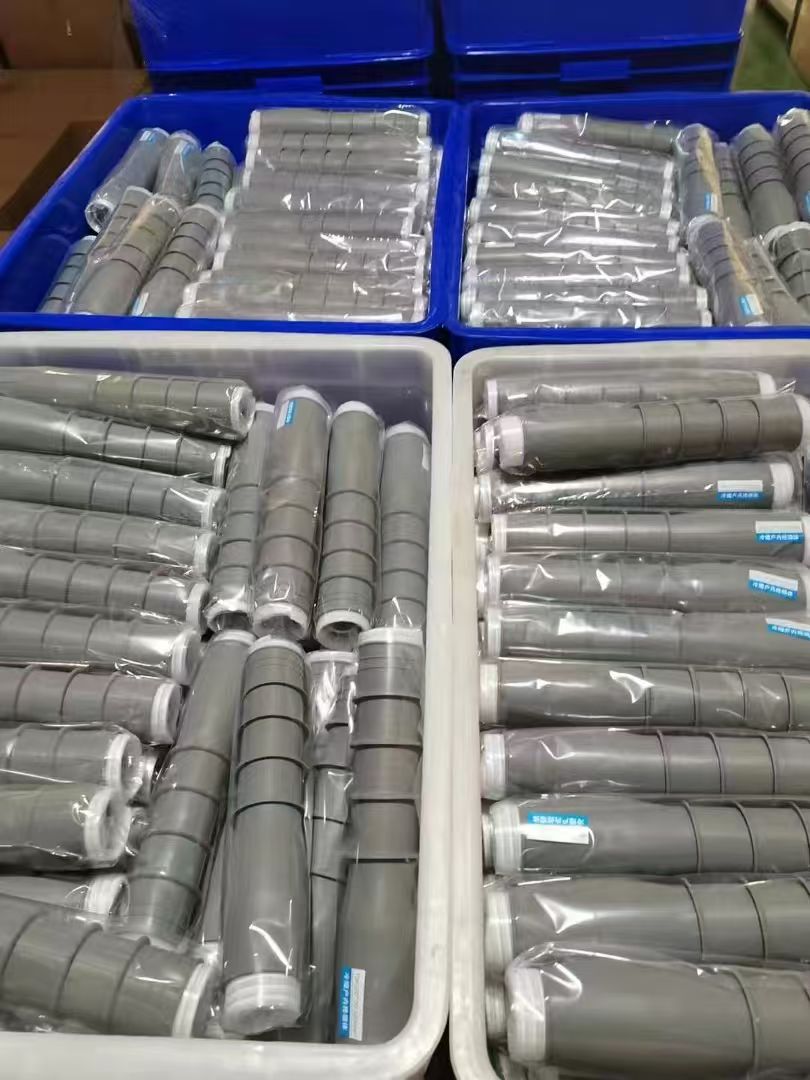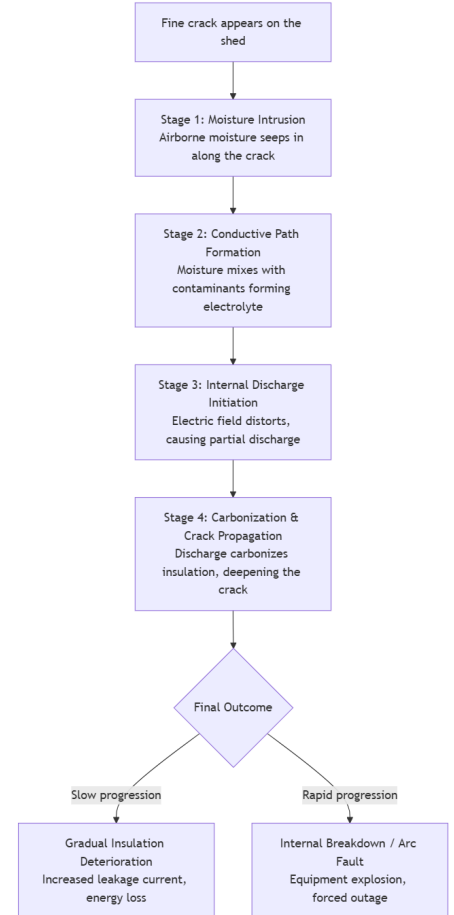
During a night patrol at a 500kV substation, maintenance staff heard a faint discharge sound from a transformer bushing. Assuming it was surface flashover due to the foggy conditions, they planned a cleaning for the next day. However, within hours, the busing exploded, causing the transformer to trip and resulting in a two-week outage for repairs. Post-analysis revealed a barely visible fine crack at the root of a porcelain shed. Moisture had infiltrated the crack, gradually developing into internal breakdown discharge, ultimately leading to complete failure.

Why Are Shed Cracks So Dangerous?
High-voltage bushings are not solid; they are hollow and filled with insulating oil or SF6 gas. Cracks on the sheds, especially those extending to the metal flange, create a direct pathway for external moisture and contaminants to reach the internal insulation.
The danger path of a crack is a continuously worsening process, as shown in the following flowchart, ultimately leading to catastrophic failure:

How to Properly Check for Shed Cracks?
When you hear a discharge sound or during routine inspections, follow these steps:
1. Timing and Environment
- Best Time: Dawn or dusk, using a flashlight with oblique illumination. The angled light creates shadows, making cracks more visible.
- Weather Conditions: After rain or in fog, cracks may absorb moisture or collect contaminants first, making them easier to spot.
- Safety Distance: Always maintain a safe distance. Use binoculars or a high-resolution camera for close observation.
2. Key Areas to Inspect
- Shed Roots: The area of highest stress concentration, most prone to cracking.
- Between Sheds: Check for longitudinal cracks connecting multiple sheds.
- Metal Flange-Porcelain Interface: Check the cement filling for cracks or crazing.
3. Crack vs. Contamination Discharge
Characteristic | Surface Contamination Discharge | Crack-Induced Discharge |
Sound | Continuous "hissing" sound | Irregular discharge with faint "cracking" sounds |
Visual | Discharge crawls along the surface, spread out | Discharge is localized, usually fixed at the crack |
Night Observation | Diffuse blue corona glow | Possible intense bright spots of discharge |
Weather Influence | Significantly worse in damp weather | Worse in damp weather but may persist in dry conditions |
What to Do If You Find a Suspect Crack? Emergency Procedure
1. Report Immediately: Report the situation (equipment ID, phase, crack location, initial assessment) to dispatch and management.
2. Enhanced Monitoring: If an immediate outage isn't possible, set up a safety perimeter and arrange regular remote monitoring (e.g., using an infrared thermometer to check for temperature changes).
3. Request Outage: Apply for a planned outage for detailed inspection ASAP. For critical equipment, consider load transfer before de-energization.
4. Professional Testing: After de-energization, technicians should confirm using:
- Visual Inspection: Use a magnifying glass for careful examination.
- Ultrasonic Testing: Perform non-destructive testing on the porcelain to detect internal flaws.
- Insulation Resistance Test: Measure the insulation resistance of the main insulation and tap (if applicable), compare with historical data.
Preventive Maintenance Suggestions
1. Create a Specific Checklist: Include bushing shed crack inspection in monthly routine patrols and special inspections (e.g., after strong winds or earthquakes).
2. Improve Technical Records: Maintain a file for each bushing with photos from each inspection to track potential crack propagation.
3. Adopt Advanced Tools: Implement drone-based HD imaging and UV imaging (corona discharge detection) to identify invisible defects early.
Summary: Safety First, Prevention is Key
The "hissing" discharge from a high-voltage bushing is its final alarm. Maintenance personnel must remember:
Listen, look, and differentiate, shed cracks are key.
Use angled light to find traces, keep a safe distance.
If you suspect a crack, report it immediately—don't wait.
Never assume it's just dirt; the consequences are too great.
Final reminder: One thorough inspection is better than ten emergency repairs. Always err on the side of caution when dealing with insulation defects in high-voltage equipment.
Oil&Gas exploited
Automotive Manufacturing
Transportation & Dlistrlbutlon
Manufacture
Industrial Construction
Green Energy
Copyright ? 2024 All Rights Reserved
Back to top 
Comment
(0)